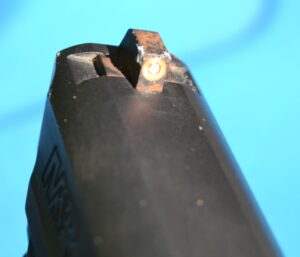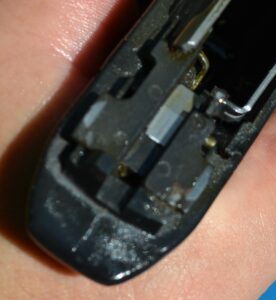“If I had six hours to chop down a tree, I’d spend the first four hours sharpening the axe.” – Abraham Lincoln
At our recent Armed Vehicle Defense program all attendees were accomplished shooters, graduates of our Level I Handgun and Rifle courses – most multiple times.
As a general rule, we include “dry practice” in every class, however, in this case it was known that all in attendance knew how to run a trigger, so we dispensed with the drill in order to save time.
I’m so glad we did!
Once we were on the range running shooting drills, a student sitting in the driver’s seat of a training vehicle drew his pistol, leaned out the open door, and attempted to fire. To no avail – his trigger was dead!
He immediately performed a “tap/rack” and tried again – still nothing!
He jettisoned his primary pistol, drew his back up, and finished the drill.
Upon inspection, his pistol (a Smith & Wesson M&P full-size in 9mm) was beyond filthy. Every roll pin was rusted, as well as the front and rear sights – it obviously hadn’t been properly maintained.
Once the slide and frame were separated, it appeared to have a broken sear as it wasn’t moving when the trigger was depressed. However, with a generous application of Gun-Scrubber and the use of a small pick, the sear was broken free from the deposit of lint/dirt/drywall dust that had wedged it in the downward position.
Sear as it was on the left, as it should be on the right
The entire pistol was sprayed off, shaken free of excess cleaner, oiled, and then re-assembled. The entire process took less than three minutes. It worked flawlessly for the remainder of the weekend.
When quizzed about the state of his gun we asked when the last time he cleaned it was – he replied that he “couldn’t remember.”
When asked why he hadn’t cleaned it, he stated that he “hadn’t fired it so why would he clean it?” After all, “it’s an M&P.”
Of course, we all laughed.
That is, until he went on to explain that his pistol was probably so dirty because of the conditions at work combined with his sweat on the job site. At which point the laughing stopped.
This was his daily carry pistol. The pistol his, and his family’s, lives depend on. The pistol, that had he been forced to defend himself that morning on the way to the range, would not have worked.
Comments
Carry guns, holsters, spare magazines, medical kits, flashlights, etc., need to be inspected weekly – whether used, or not! For those who carry in dirty environments, I recommend a thorough cleaning once-a-week, including holsters, magazines, and magazine carriers. Carry ammunition should be inspected for tarnish and damage, and wiped down before recharging into magazines.
I suggest all carry guns be chamber checked [Physically and visually confirm there is a live round in the chamber] EVERY time they are out of one’s direct control. Even when one lives alone, a chamber check should be performed when suiting up to face the day. I’m not going to hypothesize that gremlins sneaked into our guns in the middle of the night and removed the rounds, however, for all any of us know we sleepwalk. And if that scenario seems too outlandish…
John Farnam relates an event which occurred on his range decades ago while training a small sheriff’s department in the Midwest.
The drill was to have on-duty deputies drive into the range, bail out of the patrol car, and engage targets with their sidearms and carry ammo. At the time, this department was carrying Beretta 92Fs and were patrolling two deputies per car. (Yes, this was still during the 20th century.)
A set of deputies drove in, disembarked, and began firing, but only one was accomplishing anything as the other couldn’t get his trigger to move. After multiple attempts by he, and others, the armorer was called in to take a look. Nothing that was supposed to move on the pistol would! Not the trigger, slide, take down lever, manual safety, or magazine release button. Every moving part was frozen!
The pistol was eventually sent to Beretta (still fully loaded) where, after a couple of weeks, they figured it out and called the department to inquire who else had access to it, prompting an internal investigation.
Apparently, the officer in question had completed a rather ugly divorce 6-months earlier. While still co-habitating with his soon to be ex, he arrived home after his shift, he took his entire duty belt off and hung it on the coat rack by the front door, as was his habit.
In the middle of the night, his then wife un-holsterd his pistol, poured super glue into the back of it, let it dry, and placed it back into his holster.
The following morning he put on his gun belt and went to work. Over the next 6-months of duty the only time he handles his gun was when he drew and pointed his pistol at two known threats! Luckily, neither situation required shooting. In fact, he never pressed the trigger until John directed him to during training. He had been carrying a paper weight in his holster for half a year while surviving two potential lethal force encounters.
Chamber checks became policy at that department from that day, on.
Side note: in my opinion his wife’s actions amounted to attempted murder. No different than cutting the brake lines on a car. However, the local prosecutor wouldn’t touch the case – “a woman scorned”, and all that, I suppose. No arrest – never entered into any crime statistics.
Conclusion
It’s doubtful our student will ever forget this past weekend’s incident, and he’s vowed to make regular maintenance part of his routine. Of course, its my most sincere hope he does. However, it serves as a reminder to all of us that carrying guns is a lifestyle.
There are procedures and check lists that must be followed religiously, including regular maintenance and chamber checks, as-well-as proper practice and following the 4-Rules of Gun Safety. All are administrative responsibilities of daily carry. When we ignore these responsibilities, we create the conditions for disaster.
…a disaster which might not occur until years in the future!
~Frank
“Readiness is an oft-mentioned – but frequently ignored – necessity.” – Erik Prince
“The art of war teaches us to rely not on the likelihood of the enemy’s not coming, but on our own readiness to receive him; not on the chance of his not attacking, but rather on the fact that we have made our position unassailable.” – Sun Tzu












